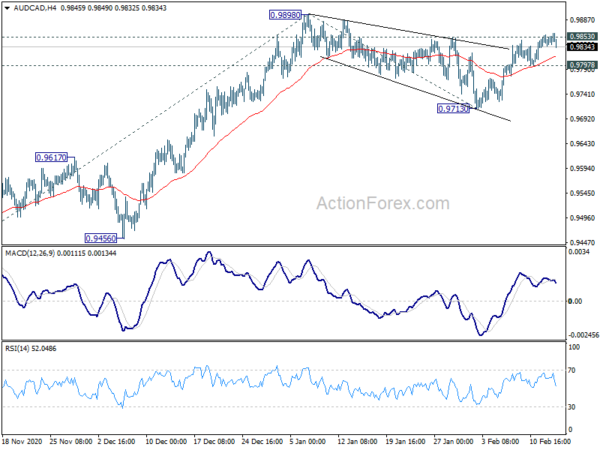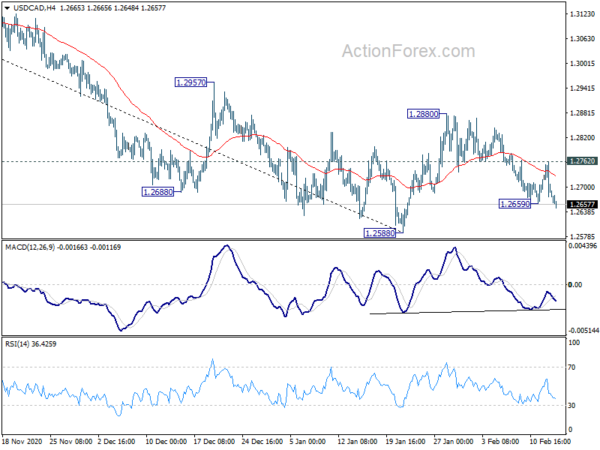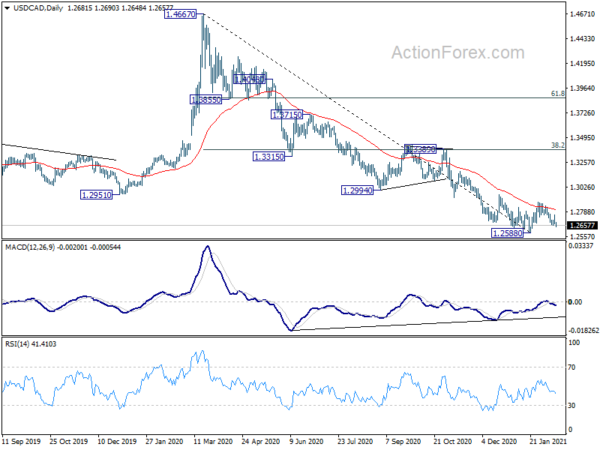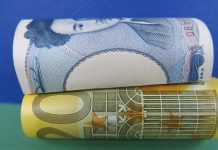Strong risk-on sentiments continue today even though US and China are on holiday. Dollar and Yen are both suffering heavy selling pressure, more so the latter. Sterling is leading the way up as Prime Minister Boris Johnson promised to detail his roadmap for lockdown exit on February 22. Canadian Dollar finally reacts to the strong rally in oil prices and lead Aussie higher. Euro and Swiss Fran are mixed, weighed down by cross selling against the Pound.
Technically, Canadian Dollar could be a focus for the rest of the day. USD/CAD’s break of 1.2659 minor support suggest resumption of fall from 1.2880 towards 1.2588 low. CAD/JPY accelerates to as high as 83.25, and it’s on track to 100% projection of 74.76 to 81.91 from 77.91 at 85.06. AUD/CAD is an interesting one to watch as it failed to sustain above 0.9853 minor resistance after various attempts. Break below 0.9797 would extend the consolidation pattern from 0.9898 with deeper fall towards 0.9713 support. That would mark a comeback of the Loonie against other commodity currencies.
In Europe, currently, FTSE is up 2.00%. DAX is up 0.38%. CAC is up 1.45%. Germany 10-year yield is up 0.0453 at -0.379. UK 10-year yield is up 0.060 at 0.581. Earlier in Asia, Nikkei rose 1.91 to 30084.15, closed above 30k for the first time in 30 years. Japan 10-year JGB yield rose s0.0160 to 0.080. Singapore Strait Times rose 0.21%.
Canada manufacturing sales rose 0.9% mom in Dec, down -11.4% in 2020
Canada manufacturing sales rose 0.9% mom to CAD 54.2B in December, well above expectation of 0.2% mom. Sales were up in 9 of 21 industries. On a quarterly basis, sales rose 1.1% qoq in Q4.
For the year of 2020, manufacturing sales dropped to their lowest level since 2016. Total manufacturing dropped -11.4% to CAD 610.6B in the year, largely because of lower sales in the transportation equipment (-23.5%) and petroleum and coal product (-37.4%) industries. Overall, sales were down in 17 of 21 manufacturing industries.
Eurozone export rose the first time since Feb in Dec
Eurozone exports rose 2.3% yoy to EUR 190.7B in December. This is the first increase since February 2020. Imports dropped -1.3% yoy to EUR 161.5B. Trade surplus came ion at EUR 29.2B. Intra-eurozone trade rose to EUR 148.7B, by 0.9% yoy.
In seasonally adjusted term, Eurozone exports rose 1.1% mom to EUR 191.6B. Imports dropped -0.3% mom to EUR 164.0B. Trade surplus widened to EUR 27.5B, above expectation of EUR 22.3B.
Eurozone industrial production dropped -1.6% mom in Dec, EU down -1.2% mom
Eurozone industrial production dropped -1.6% mom in December, worse than expectation of -0.6% mom. Production of capital goods fell by -3.1% mom and non-durable consumer goods by -0.6% mom, while production of durable consumer goods rose by 0.8% mom, intermediate goods by 1.0% mom and energy by 1.4% mom.
EU industrial production dropped -1.2% mom. Among Member States, for which data are available, the largest decreases were registered in Hungary (-2.5% mom), Belgium (-1.9% mom) and Finland (-0.9% mom). The highest increases were observed in Denmark (+2.4% mom), Portugal (+1.8% mom), Estonia and Luxembourg (both +1.6% mom).
Japan GDP grew 12.7% annualized, 3.0% qoq in Q4, well above expectations
Japan’s GDP grew 12.7% annualized in Q4, well above expectation of 9.5%. On quarterly terms, GDP grew 3.0% qoq, beat expectation of 2.3% qoq. Looking at some details, private consumption rose 2.2% qoq, above expectation of 1.8% qoq. Capital expenditure rose 4.5% qoq, above expectation of 2.6% qoq. External demand rose 1.0% qoq, matched expectations. Price index, however, rose just 0.2% yoy, missed expectation of 0.5% yoy.
Economy Minister Yasutoshi Nishimura said that the set of data showed the economy’s capacity on recovery. Nevertheless, consumer spending remained below average. Exports could also weaken if the coronavirus infections prompts more restrictions in other markets like Europe. The country is not out of the woods yet.
Also from Japan, industrial production was finalized at -1.0% mom in December.
New Zealand BusinessNZ services dropped to 47.9, generally negative
New Zealand BusinessNZ Performance of Services dropped -1.2 pts to 47.9 in January, signal deeper contraction. The index was also well below long term average of 53.8 for the survey. Looking at some details, activity/sales dropped from 51.0 to 46.4. Employment dropped from 52.8 to 46.9. New orders, though, improved from 50.9 to 53.7.
BusinessNZ chief executive Kirk Hope said that the January result was generally negative when examined more deeply. “Looking at the comments made by respondents, the ongoing trend of contraction was typified by the influences of the Xmas period, ongoing COVID-19 related issues (including freight challenges) and a slower return to business as usual post holidays”.
USD/CAD Mid-Day Outlook
Daily Pivots: (S1) 1.2659; (P) 1.2711; (R1) 1.2745; More….
USD/CAD’s break of 1.2659 suggests resumption of fall from 1.2880. Intraday bias is back on the downside for retesting 1.2588 low. Decisive break there will resume larger down trend from 1.4667. On the upside, though, break of 1.2762 will extend the consolidation pattern from 1.2588 with another rise.
In the bigger picture, fall from 1.4667 is seen as the third leg of the corrective pattern from 1.4689 (2016 high). Further decline should be seen back to 1.2061 (2017 low). In any case, break of 1.3389 resistance is needed to indicate medium term bottoming. Otherwise, outlook will remain bearish in case of rebound.
Economic Indicators Update
| GMT | Ccy | Events | Actual | Forecast | Previous | Revised |
|---|---|---|---|---|---|---|
| 23:50 | JPY | GDP Q/Q Q4 P | 3.00% | 2.30% | 5.30% | |
| 23:50 | JPY | GDP Deflator Y/Y Q4 P | 0.20% | 0.50% | 1.20% | |
| 00:01 | GBP | Rightmove House Price Index M/M Feb | 0.50% | -0.90% | ||
| 04:30 | JPY | Industrial Production M/M Dec F | -1.00% | -1.60% | -1.60% | |
| 10:00 | EUR | Eurozone Trade Balance (EUR) Dec | 27.5B | 22.3B | 25.1B | 24.9B |
| 10:00 | EUR | Eurozone Industrial Production M/M Dec | -1.60% | -0.60% | 2.50% | 2.60% |
| 13:30 | CAD | Manufacturing Sales M/M Dec | 0.90% | 0.20% | -0.60% |
















